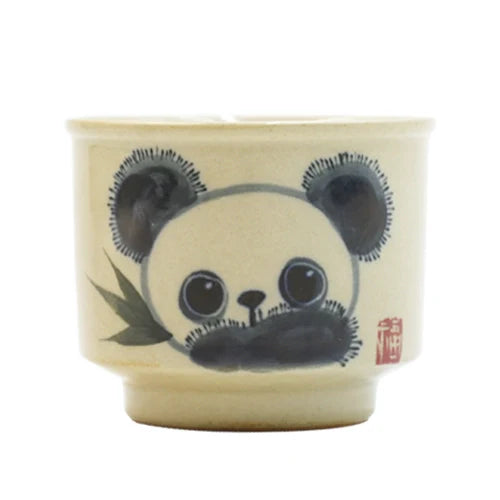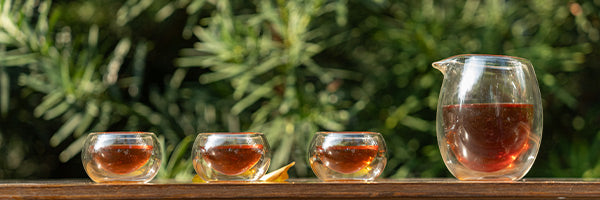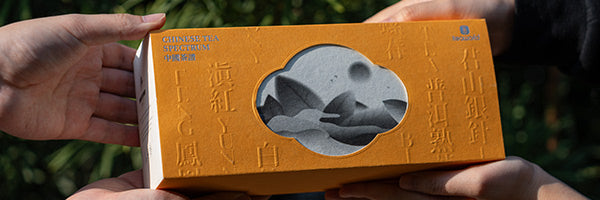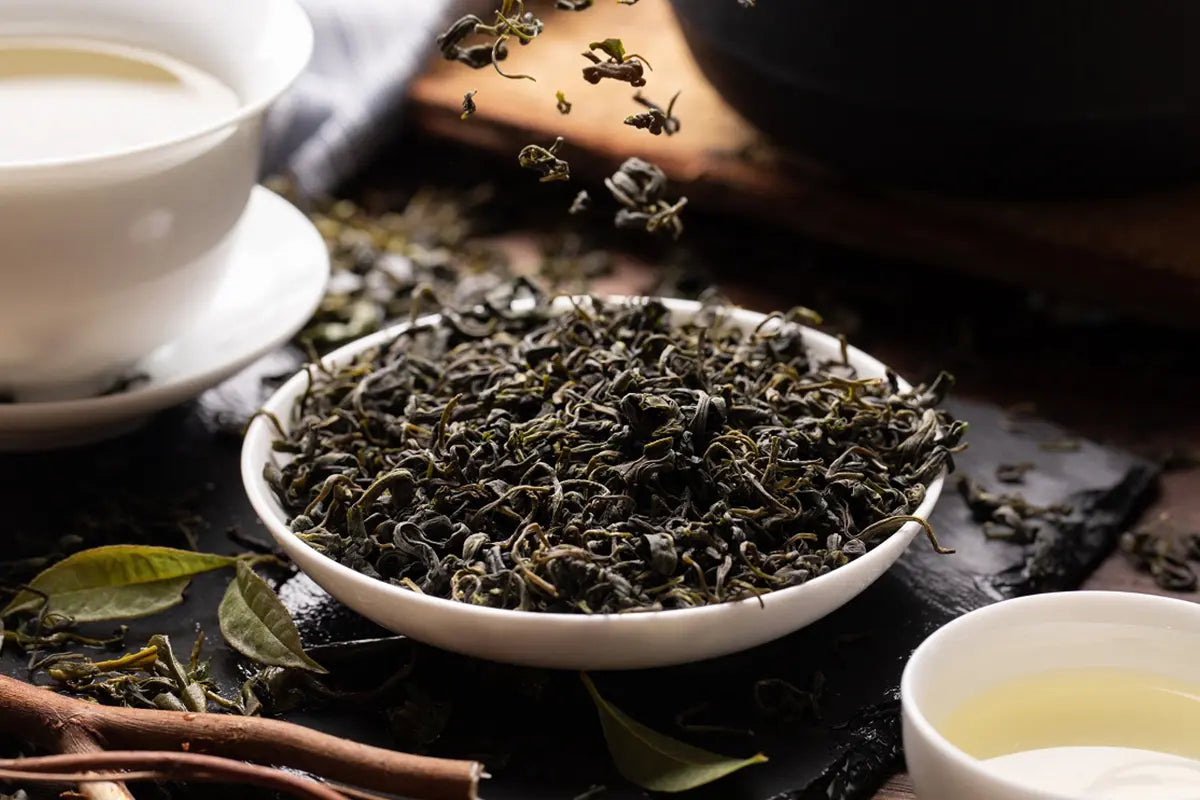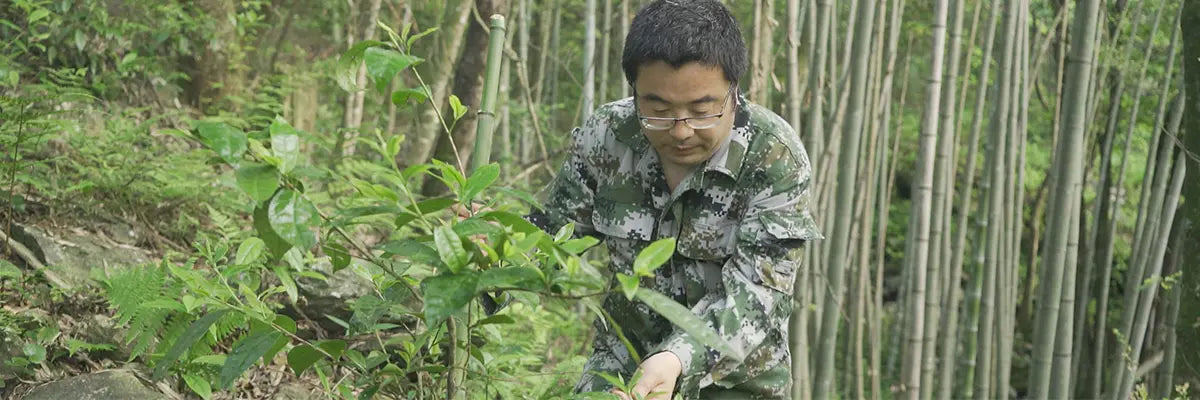Рассыпной улун, также известный как «цинча», — это вид полуферментированного чая, возникший в эпоху династий Мин и Цин в Китае. Этот вид чая, созданный фермерами Аньси на основе метода заваривания зелёного чая, сначала распространился по северной части провинции Фуцзянь и провинции Гуандун, а затем добрался до Тайваня.
Среди различных видов китайского чая листовой улун выделяется как отдельная категория, заслужив репутацию «зелёного листа с красной каймой». Он высоко ценится за свой уникальный аромат и вкус.
Те, кто хочет попробовать рассыпной улун, найдут для себя широкий выбор. Если вас заинтересовал рассыпной улун, но вы не знаете, как выбрать подходящий? Рекомендуем вам приобрести дегустационный набор улуна, чтобы оценить свои предпочтения. Ниже мы подобрали для вас 10 известных рассыпных улунов.
Знакомство с 10 лучшими сортами рассыпного чая улун
1. Те Гуань Инь
Улун Тегуаньинь — один из представителей рассыпного чая, производимого преимущественно в западной части уезда Аньси провинции Фуцзянь, известной как «Внутренний Аньси». Сухие чайные листья Тегуаньинь плотно скручены, крепки и обладают песочно-зелёным блеском, напоминающим спираль. Известный своим крепким и бодрящим ароматом, Тегуаньинь, как говорят, обладает «более чем семью настоями с стойким ароматом». Считается также, что он обладает омолаживающими свойствами, дарит ясное тепло и освежает разум.
2. Да Хун Пао
Да Хун Пао улун Известен как «король чая Уи» и «лучший знаток среди чаёв». Плотно скрученные листья Да Хун Пао имеют глянцевый тёмно-зелёно-коричневый цвет. Сухие чайные листья источают чистый и аутентичный аромат. При заваривании Да Хун Пао даёт прозрачный настой оранжевого оттенка с насыщенным и освежающим ароматом. Вкус сладкий, мягкий и восхитительный. Отличительной чертой Да Хун Пао является его насыщенный и стойкий аромат, который часто описывают как обладающий ярко выраженным «очарованием скалы».
3. Дундин Улун

Дундин улун родом из посёлка Лугу на Тайване, названного в честь района его произрастания на горе Дундин. Этот высококачественный чай хорошо известен на Тайване, но его производство ограничено, а цена относительно высока. При заваривании Дундин улун приобретает медово-зелёный оттенок с лёгким золотисто-жёлтым оттенком в настое. Аромат элегантный, вкус насыщенный и сладкий.
4. Фэнхуан Даньцун

Фэнхуан Даньцун (Феникс Даньцун) — сорт чая, произрастающий на горе Фэнхуан в городе Чаочжоу, провинция Гуандун. Известный своим превосходным качеством, Фэнхуан Даньцун отличается крепкими, прямыми, сухими листьями блестящего жёлто-коричневого цвета. Листья украшены ярко-красными точками. После заваривания чайный настой ярко-жёлтого цвета, прозрачный, с уникальным и стойким ароматом. Вкус насыщенный, мягкий и освежающий, с характерным «горным очарованием».
Попробуйте 10 лучших китайских чаев улун из нашей коллекции.>>>
5. Ти Ло Хань

Чай «Те Лохань», созданный в эпоху Цяньлун династии Цин, производится на знаменитой горе Уи в северной части провинции Фуцзянь. Он прекрасно растёт и созревает в расщелинах скал. Чай «Те Лохань» отличается плотно скрученными листьями блестящего зелёно-коричневого цвета. При заваривании «Те Лохань» приобретает яркий оранжево-жёлтый цвет, а листья отличаются особой красотой – зелёными листьями с красной каймой.
6. Хуанцзинь Гуй

Хуанцзинь Гуй Родом из провинции Фуцзянь и является одним из самых ранних сортов рассыпного улуна. Он также считается прекрасным сортом чайного дерева в Китае. Аромат Хуанцзинь Гуй напоминает аромат цветков кассии. После заваривания чайный настой приобретает ярко-золотистый полупрозрачный цвет и обладает выраженным, бодрящим ароматом, за что его прозвали «Непревзойденным ароматом».
7. Бай Цзи Гуань
Улун Бай Цзи Гуань — эксклюзивный «дао-чай» с горы Уи. Его уникальный внешний вид характеризуется светло-зелёными листьями с белыми прожилками. Чайные почки, покрытые пушком, напоминают полумесяц, создавая впечатление гребня петуха. Сухой чай Бай Цзи Гуань имеет насыщенный бледно-жёлтый оттенок с белыми оттенками. При заваривании чайный настой приобретает яркий оранжево-жёлтый цвет, оставляя стойкий аромат на губах и зубах, с насыщенным и энергичным вкусом.
8. Шуй Цзинь Гуй
Шуй Цзинь Гуй — один из четырёх знаменитых чаёв Мин Цун, производимых компанией Wuyi Rock Tea. Его название, означающее «Водяная Золотая Черепаха», происходит от плотного и блестящего вида чайных листьев, напоминающих золотистую черепаху. Сухой чай Шуй Цзинь Гуй имеет глянцевый зелёно-коричневый цвет с толстыми и сочными листьями. Чайный настой прозрачный, золотисто-жёлтый, со сладким вкусом без горечи и терпкости, с выраженным, бодрящим ароматом.
Попробуйте редкие чаи из Ушаня с нашим набором улунских чаев.>>>
9. Чжанпин Шуйсянь
Улун Чжанпин Шуйсянь – единственный прессованный чай среди рассыпных улунов. Производство и вкус чайных блинчиков Чжанпин Шуйсянь отличаются особой спецификой. Свежие чайные листья Шуйсянь проходят такие процессы, как вэйдяо (высушивание на солнце), цзоцин (встряхивание и замачивание), шацин (сушка) и жунянь (скручивание), прежде чем их прессуют в квадратные блинчики с помощью деревянных форм. После тщательной упаковки в мягкую бумагу и точной обжарки на углях, блинчики Чжанпин Шуйсянь приобретают уникальный стиль и сохраняют традиционный вкус. Чайный настой Чжанпин Шуйсянь отличается чистым золотистым цветом и изысканным ароматом с тонким оттенком османтуса.
10. Восточная красавица
Чай «Восточная Красавица» — уникальный рассыпной улун, произрастающий на Тайване (Китай), также известный как чай «Понг Фонг». Его отличительной чертой являются ярко выраженные белые пушистые почки, благодаря которым он получил название «Белый пушистый улун». Среди полуферментированных рассыпных улунских чаёв «Восточная Красавица» известен своей высокой степенью ферментации. Вкус «Восточной Красавицы» насыщенный и мягкий, оставляя стойкий аромат на губах и зубах, оставляя приятное послевкусие.
Попробуйте 10 лучших классических китайских улунов для начинающих из этой коллекции чая улун. >>>

Как заваривать улун?
При заваривании улуна выбор посуды имеет большое значение. Два самых традиционных и эффективных инструмента — это гайвань и глиняный чайник . Каждый из них позволяет по-своему раскрыть различные характеристики улуна .
1. Заваривание в гайвани
Гайвань идеально подходит для ароматизированных, слегка ароматизированных чаёв. Поскольку она не сохраняет аромат и вкус предыдущих заварок, она позволяет каждому чаю чётко раскрыться. Гайвань также легко контролировать и идеально подходит для быстрого и чистого наливания.
Почему белый фарфор?
Белые фарфоровые гайвани чистые, гладкие и слегка полупрозрачные, что позволяет легко наблюдать за тем, как раскрываются чайные листья, и как меняется цвет настоя. Они особенно хорошо подходят для новичков, желающих попробовать все шесть основных видов китайского чая .
Способ заваривания в гайвани:
-
Подогрейте гайвань.
-
Добавьте 6–7 г чая (примерно в соотношении 1:15).
-
Разбудите аромат — нежно понюхайте теплые сухие листья (не вдыхайте в гайвань)
-
Промыть листья — быстро залить, затем вылить.
-
Первая заварка — кипяток (100°C), настаивать 10 секунд
-
Взгляд → Понюхать → Сделать глоток
2. Заваривание в глиняном чайнике (Исин)
Глиняные чайники, особенно из исинской фиолетовой глины , отлично подходят для более насыщенных и крепких улунов. Со временем пористая глина впитывает аромат и вкус чая, обогащая последующие заваривания.
Лучше всего использовать для:
-
Каменный чай Уи ( например, Да Хун Пао )
-
Феникс Дан Конг ( например, Ми Лан Сян )
-
Традиционный жареный Те Гуань Инь
Как заваривать в глиняном чайнике:
-
Прогрейте и разбудите чайник — ополосните его снаружи и внутри кипятком, чтобы нагреть сосуд и активировать поры глины.
-
Добавьте 6–7 г чая (для более крепкого чая может потребоваться больше)
-
Промойте листья — быстро, обдайте кипятком и сразу же вылейте.
-
Основное пиво
-
Используйте кипящую воду (100°C)
-
Налейте воду низко, по внутренней стенке горшка (избегайте прямого попадания на листья).
-
Заваривайте в течение 15 секунд для первой заварки, затем добавляйте по 5 секунд для каждой последующей заварки.
-
Вылейте полностью; наклоните горшок, чтобы обеспечить равномерное выливание.
-
-
Вкус
На что обратить внимание:
-
Внешний вид : насыщенный янтарный, слегка маслянистый и прозрачный.
-
Запах : Длительный аромат с нотками угля и фруктов.
-
Глоток : Богатый, насыщенный, с выраженным минеральным или горным характером.
Потенциальная польза для здоровья листового чая улун
Чай улун способствует снижению веса
Чай улун обладает жиросжигающим эффектом, способствующим снижению веса, поскольку основной компонент чая — танины — тесно связан с жировым обменом.
По сравнению с чёрным и зелёным чаем, улун не только стимулирует активность липолитических ферментов поджелудочной железы и снижает усвоение сладкой и жирной пищи, но и ускоряет выработку калорий в организме, способствует сжиганию жира и уменьшает накопление жира в области живота. Поэтому улун — это чай, который выбирают для похудения и уменьшения жировых отложений.
Снижение уровня липидов в крови:
Улун обладает способностью предотвращать и снижать атеросклеротическое действие липидов в крови аорты. Употребление улуна также снижает вязкость крови, предотвращает агрегацию эритроцитов, улучшает гиперкоагуляцию крови, повышает её текучесть и улучшает микроциркуляцию. Тест на тромбоз in vitro также показывает, что улун подавляет тромбообразование.
Понижение артериального давления:
Исследование 2004 года показало, что употребление улуна помогает снизить высокое кровяное давление. У людей, выпивавших одну чашку чая в день, вероятность снижения артериального давления была на 45% выше, чем у других, а при употреблении двух чашек этот показатель мог повышаться до 65%. Различные исследования показали, что улун ускоряет метаболизм и сжигание жира, а также улучшает усвоение жиров из пищи. Он содержит катехины – полифенолы, сжигающие калории, которые в сочетании с физическими упражнениями и сбалансированным питанием могут быть отличным способом похудения.
Умственно энергичный:
Поскольку в чае улун содержится кофеин, он полезен для восстановления сил и поддержания хорошего настроения.
Каждый из этих знаменитых рассыпных улунских чаёв обладает уникальным вкусом и богатой историей. Чтобы по-настоящему оценить их красоту, лучше всего попробовать и поэкспериментировать с ними лично. Надеемся, эта статья дала вам ценные знания о рассыпных улунских чаях и сделает ваше путешествие в мир чая более насыщенным и приятным.
Наш Discord уже запущен — присоединяйтесь к нам и общайтесь с другими любителями чая !





















































